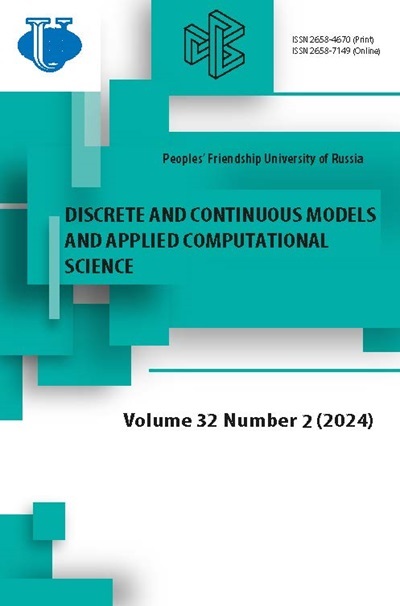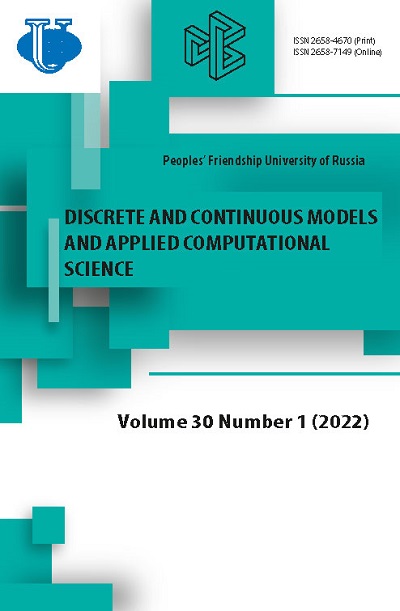К анализу системы массового обслуживания для сети 5G с технологией NS и приоритетным управлением доступом к радиоресурсам
- Авторы: Аду К.И.1, Маркова Е.В.1, Жбанкова Е.А.1
-
Учреждения:
- Российский университет дружбы народов
- Выпуск: Том 30, № 1 (2022)
- Страницы: 5-20
- Раздел: Статьи
- URL: https://journals.rudn.ru/miph/article/view/30323
- DOI: https://doi.org/10.22363/2658-4670-2022-30-1-5-20
Цитировать
Полный текст
Аннотация
Переход к беспроводным сетям пятого поколения 5G ознаменовал новый этап развития информационных и коммуникационных технологий. Сети пятого поколения должны решить такие проблемы, как негибкость «традиционных» сетей и нехватка частотных радиоресурсов для качественного предоставления услуг. Предполагается, что, используя эти сети, мобильные операторы смогут значительно расширить спектр услуг и обеспечить требуемое качество их предоставления. Для удовлетворения требований к качеству обслуживания ( англ. Quality of Service - QoS) операторам необходимо выполнение «ключевых показателей эффективности» ( англ. Key Performance Indicators - KPI), описанных в стандартах связи. Для этой цели могут быть использованы алгоритмы приоритетного облуживания. В статье рассмотрена модель беспроводной сети 5G, поддерживающая технологию нарезки сети и реализующая управление доступом к сетевым радиоресурсам при помощи введения приоритетов. Изучена работа модели в рамках двух алгоритмов. Проведён сравнительный анализ основных показателей эффективности модели.
Ключевые слова
Об авторах
К. И. Б. Аду
Российский университет дружбы народов
Автор, ответственный за переписку.
Email: 1042205051@rudn.ru
ORCID iD: 0000-0003-4669-0898
PhD Student at the Department of Applied Probability and Informatics, Faculty of Science
ул. Миклухо-Маклая, д. 6, Москва, Россия, 117198Е. В. Маркова
Российский университет дружбы народов
Email: markova-ev@rudn.ru
ORCID iD: 0000-0002-7876-2801
Candidate of Physical and Mathematical Sciences, Associate Professor at the Department of Applied Probability and Informatics, Faculty of Science
ул. Миклухо-Маклая, д. 6, Москва, Россия, 117198Е. А. Жбанкова
Российский университет дружбы народов
Email: 1032202159@rudn.ru
ORCID iD: 0000-0003-2482-4488
MSc student at the Department of Applied Probability and Informatics, Faculty of Science
ул. Миклухо-Маклая, д. 6, Москва, Россия, 117198Список литературы
- W. Lehr, F. Queder, and J. Haucap, “5G: A new future for Mobile Network Operators, or not?” Telecommunications Policy, vol. 45, no. 3, p. 102086, Jan. 2021. doi: 10.1016/j.telpol.2020.102086.
- Z. Ofir. “What will be the impact of 5g on network operators?” (Nov. 2021), [Online]. Available: https://www.forbes.com/sites/forbestechcouncil/2020/11/24/what-will-be-the-impact-of5g-on-network-operators/.
- “Cloud computing services drive companies’ digital transformation.” (Jan. 2022), [Online]. Available: https://www.telefonica.com/en/communication-room/blog/cloud-computing-services-drivecompanies-digital-transformation/.
- K. Budka. “AI + Augmented: Pushing the Limits of What Machines Can Do.” (Sep. 2021), [Online]. Available: https://www.industryweek.com/technology-and-iiot/emerging-technologies/article/ 21174112/ai-augmented-pushes-the-limits-of-what-machinescan-do.
- C. Johnson. “What Companies And Governments Really Want From Industry 4.0.” (Nov. 2021), [Online]. Available: https://www.forbes.com/sites/nokia-industry-40/2021/11/18/what-companies-andgovernments-really-want-from-industry-40/.
- Nokia. “How Supply Chain 4.0 delivers the goods other approaches can’t.” (Dec. 2021), [Online]. Available: http://www.ft.com/partnercontent/nokia/how-supply-chain-4-0-delivers-thegoods-other-approaches-cant.html.
- A. Sultan and M. Pope, “Feasibility study on new services and markets technology enablers for network operation; Stage 1,” 3rd Generation Partnership Project (3GPP), Technical report (TR) 22.864, Sep. 2016, Version 15.0.0.
- J. M. Meredith, F. Firmin, and M. Pope, “Release 16 Description; Summary of Rel-16 Work Items,” 3rd Generation Partnership Project (3GPP), Technical report (TR) 21.916, Jan. 2022, Version 16.1.0.
- J. M. Meredith, M. C. Soveri, and M. Pope, “Management and orchestration; 5G end to end Key Performance Indicators (KPI),” 3rd Generation Partnership Project (3GPP), Technical specification (TS) 28.554, Dec. 2021, Version 17.5.0.
- “5G industry campus network deployment guideline,” GSM Association (GSMA), Official Document NG.123, Oct. 2021, Version 2.0.
- I. Markopoulos et al., “Service performance measurement methods over 5G experimental networks,” 5G PPP, white paper ICT-19, Mar. 2021, Version 1.0. doi: 10.5281/zenodo.4748482.
- L. Nielsen et al., “Basic Testing Guide - A Starter Kit for Basic 5G KPIs Verification,” 5G PPP, white paper, Nov. 2021, Version 1.0. doi: 10.5281/zenodo.5704519.
- O. Ohlsson, P. Wallentin, and C.-G. Persson. “Reducing mobility interruption time in 5G networks.” (Apr. 2020), [Online]. Available: https://www.ericsson.com/en/blog/2020/4/reducing-mobilityinterruption-time-5g-networks.
- G. Sevilla. “2022 predictions: Internet and network outages will continue to get worse before they get better.” (Dec. 2021), [Online]. Available: https://www.emarketer.com/content/2022-predictionsinternet-network-outages-will-continue-worse-before-theybetter.
- H. Zhu, G. Zhang, D. Hong, S. Zhang, and S. Huang, “Data Access Control Method of Power Terminal Based on 5G Technology,” in Advanced Hybrid Information Processing, S. Liu and X. Ma, Eds., Cham: Springer International Publishing, 2022, pp. 26-39. doi: 10.1007/978-3-03094554-1_3.
- D. Alotaibi, V. Thayananthan, and J. Yazdani, “The 5G network slicing using SDN based technology for managing network traffic,” Procedia Computer Science, vol. 194, pp. 114-121, Dec. 2021, 18th International Learning & Technology Conference 2021. doi: 10.1016/j.procs.2021.10.064.
- R. Moreira, P. F. Rosa, R. L. A. Aguiar, and F. de Oliveira Silva, “NASOR: A network slicing approach for multiple Autonomous Systems,” Computer Communications, vol. 179, pp. 131-144, Jul. 2021. DOI: 10. 1016/j.comcom.2021.07.028.
- P. Zhu, J. Zhang, Y. Xiao, J. Cui, L. Bai, and Y. Ji, “Deep reinforcement learning-based radio function deployment for secure and resource-efficient NG-RAN slicing,” Engineering Applications of Artificial Intelligence, vol. 106, p. 104490, 2021. doi: 10.1016/j.engappai.2021.104490.
- H. Yang, T. So, and Y. Xu, “Chapter 12 - 5G network slicing,” in 5G NR and Enhancements, J. Shen, Z. Du, Z. Zhang, N. Yang, and H. Tang, Eds., Elsevier, 2022, pp. 621-639. doi: 10.1016/B978-0-323-910606.00012-X.
- N. Suganthi and S. Meenakshi, “An efficient scheduling algorithm using queuing system to minimize starvation of non-real-time secondary users in Cognitive Radio Network,” Cluster Computing, vol. 25, no. 1, pp. 1-11, Jan. 2022. doi: 10.1007/s10586-017-1595-8.
- A. Fathalla, K. Li, and A. Salah, “Best-KFF: a multi-objective preemptive resource allocation policy for cloud computing systems,” Cluster Computing, vol. 25, no. 1, pp. 321-336, Feb. 2022. doi: 10.1007/s10586021-03407-z.
- S. J. Ahmad et al., “A Dynamic Priority Based Scheduling Scheme for Multimedia Streaming Over MANETs to Improve QoS,” in Distributed Computing and Internet Technology, Cham: Springer International Publishing, 2016, pp. 122-126. doi: 10.1007/978-3-319-28034-9_15.
- A. Belgacem and K. Beghdad-Bey, “Multi-objective workflow scheduling in cloud computing: trade-off between makespan and cost,” Cluster Computing, vol. 25, no. 1, pp. 579-595, Feb. 2022. doi: 10.1007/s10586021-03432-y.
- J. R. Artalejo and A. Gómez-Corral, Retrial Queueing Systems. Springer, Berlin, Heidelberg, Jan. 2008. doi: 10.1007/978-3-540-78725-9.
- P. P. Bocharov, C. D’Apice, and A. V. Pechinkin, Queueing Theory. De Gruyter, 2011. doi: 10.1515/9783110936025.
- G. P. Basharin, Y. V. Gaidamaka, and K. E. Samouylov, “Mathematical Theory of Teletraffic and its Application to the Analysis of Multiservice Communication of Next Generation Networks,” Automatic Control and Computer Sciences, vol. 47, no. 2, pp. 62-69, 2013. DOI: 10.3103/ S0146411613020028.
- K. Y. Adou and E. V. Markova, “Methods for Analyzing Slicing Technology in 5G Wireless Network Described as Queueing System with Unlimited Buffer and Retrial Group,” in Information Technologies and Mathematical Modelling. Queueing Theory and Applications, Cham: Springer International Publishing, Mar. 2021, pp. 264-278. doi: 10.1007/978-3-030-72247-0_20.
- E. Markova, Y. Adou, D. Ivanova, A. Golskaia, and K. Samouylov, “Queue with Retrial Group for Modeling Best Effort Traffic with Minimum Bit Rate Guarantee Transmission Under Network Slicing,” in Distributed Computer and Communication Networks, Cham: Springer International Publishing, 2019, pp. 432-442. DOI: 978-3-030-366148_33.
- M. Korenevskaya, O. Zayats, A. Ilyashenko, and V. Muliukha, “Retrial Queuing System with Randomized Push-Out Mechanism and NonPreemptive Priority,” Procedia Computer Science, vol. 150, pp. 716-725, 2019, Proceedings of the 13th International Symposium “Intelligent Systems 2018” (INTELS’18), 22-24 October, 2018, St. Petersburg, Russia. doi: 10.1016/j.procs.2019.02.016.
- A. M. Yadav, K. N. Tripathi, and S. C. Sharma, “An enhanced multiobjective fireworks algorithm for task scheduling in fog computing environment,” Cluster Computing, Nov. 2021. doi: 10.1007/s10586021-03481-3.
- S. N. Stepanov, Fundamentals of Multiservice Networks [Osnovy teletraffika multiservisnykh setei]. Moscow: Eqo-Trends, 2010, p. 392, in Russian.
- S. N. Stepanov, Theory of Teletraffic: Concepts, Models, Applications [Teoriya teletraffika: kontseptsii, modeli, prilozheniya]. Moscow: Goryachaya Liniya-Telekom, 2015, p. 868, in Russian.
















